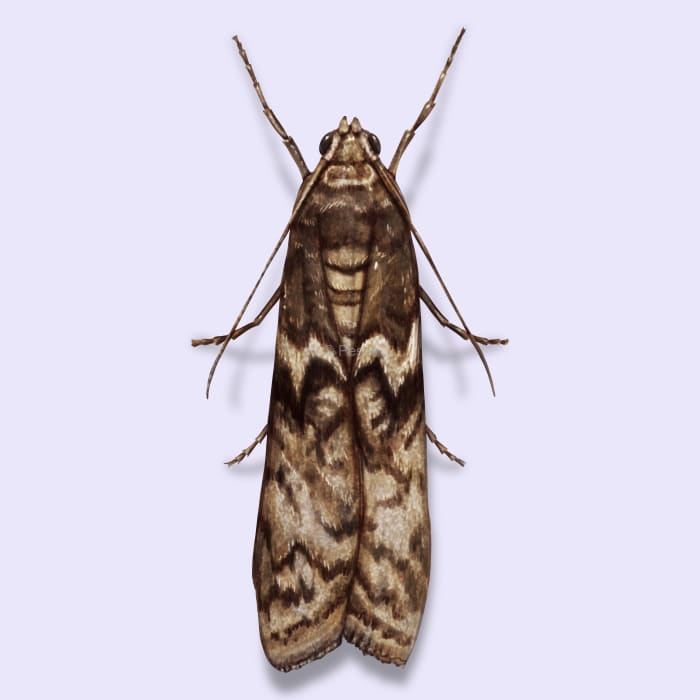How to identify and get rid of Mediterranean flour moths

Don’t let moths ruin your pantry
Have you ever opened your pantry to find small, pale gray moths fluttering around or noticed your flour clumping together in strange webs? Unfortunately, you might be the victim of a Mediterranean flour moth infestation.
These pantry pests are known for infesting stored food products, especially grains, and can quickly turn your kitchen into a moth buffet if left unchecked. While they’re not dangerous to humans, they can ruin your food and be a real nuisance.
Mediterranean flour moths lay their eggs in stored food products, which you then buy and take into your home. Little did you know, the larvae hatch in your food and start feeding, spinning silken webs that cause food particles to stick together. After several weeks, they pupate and emerge as adult moths, ready to start the cycle all over again. If you don’t happen to notice the adults or larvae, they can quickly become a big problem in your pantry.
How to identify Mediterranean flour moths
Mediterranean flour moths are relatively easy to identify if you know what to look for. The adult moths are pale gray with wavy, zigzag black lines across their wings and hold their wings in a distinctive tent-like position with slightly upturned tips when at rest. The larvae are dirty white and typically found in stored grain products, where they spin silken webs that often cause the grains to clump together. If you notice small, pale gray moths fluttering around your pantry or see grain products sticking together with fine silk, you might be dealing with a Mediterranean flour moth infestation.
How big are Mediterranean flour moths?
Adult Mediterranean flour moths have a wingspan of around 3/4 inch.
Where do Mediterranean flour moths live?
They are found throughout the United States, particularly in homes, grocery stores, and warehouses where flour and grain products are stored. You’ll most likely find them in your pantry, cupboards, or any place where dry goods like flour, cereal, grains, and pasta are stored.
How to get rid of Mediterranean flour moths
Unfortunately, Mediterranean flour moths are usually brought in with infested stored food products. That means you will need to be vigilant at looking at your flour, grains, or dried foods when you buy them or put them in your pantry.
You can manage a Mediterranean flour moth problem by:
- Inspecting and discarding infested products: Carefully check all dry goods in your pantry and discard any that show signs of infestation, such as clumped grains or webs.
- Storing food properly: Keep dry goods in airtight containers to prevent moths from accessing them.
- Cleaning your pantry: Thoroughly clean your pantry shelves, including cracks and crevices, to remove any lingering moths, eggs, or larvae.
- Freezing: If you suspect food items might be infested, place them in the freezer for at least a week to kill any larvae or eggs.
Treat mediterranean flour moths with Pestie
If you're still having trouble keeping mediterranean flour moths away, the best option is to use a pro-grade, effective pest control solution like Pestie.
Pestie is a do-it-yourself pest control solution that's specially designed to keep mediterranean flour moths and other pests away from your home.
With Pestie, you can rest easy knowing that your living space is protected and free of creepy crawlies. And the best part? It's designed for people, pets, and the planet, so you can say goodbye to harsh chemicals and hello to peace of mind!
- Save hundreds compared to traditional annual pest plans
- People, pet, and planet-friendly
- Pro-grade customized formulas
Quick facts
- Scientific name
Ephestia Kuehniella
- Other common names
Mill Moths
- Colors
Pale gray
- Life span
6-8 weeks
- Diet
Flour, cereals, grains, pasta, dried fruits
How dangerous are Mediterranean Flour Moths?
Low danger risk
Mediterranean flour moths don’t bite or spread diseases, but they can contaminate food products
Mediterranean flour moths are originally from Europe and weren’t a problem in the US until the 1980s. Now, it’s a common pest in houses, restaurants, grocery stores, and warehouses.








